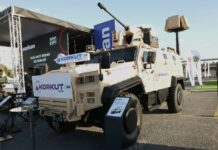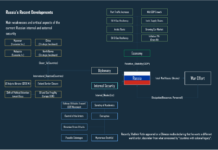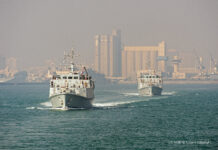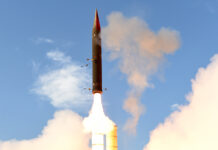In the last five years, Turkey`s arms industry has not only gained momentum in the export of weapons systems, but at the same time has been able to reduce imports only to the essential.
The Arab Spring has changed the regional dynamics due to ongoing ethnic and political conflicts in such a way that Turkey has been forced to redefine the geopolitical instruments in its foreign and security policy. In particular, Turkey’s defence industry as an instrument of power has to provide its innovative capabilities as a contribution to the country’s foreign policy strategy. However, arms exports not only deepen diplomatic relations with the respective countries in terms of foreign policy, it also makes it easier for the Turkish Armed Forces to carry out their security missions geographically.
Maintaining an Edge
Of course, it is in the nature of any country eager to maintain its military superiority in crisis regions and at the same time gain qualitative advantages over foreign policy rivals that Ankara has been investing for at least a decade and very seriously in innovative weapons systems, including weapons based on new technical principles. There is considerable discussion in the media about Turkish UAVs acting as ‘game-changers’ in crisis regions, innovative missile systems, new frigates and fighter planes, but what has been pushed into the background are Directed-Energy Weapons (DEW) and railguns. DEWs are weapon systems that can disable or destroy military targets with focused energy. Tübitak announced in 2015 at the IDEF fair that they have successfully hit targets with lasers. Six years later, Tübitak has presented an even larger laser gun that is being considered for permanent installation on Turkish warships in the near future.
Laser Guns
The laser guns can already be seen on BMC armoured cars, and on the OTOKAR COBRA also. Such a gun could definitely bring down an unarmoured helicopter, and without any problems with stronger laser power, it would also be possible to bring down armoured helicopters. Aselsan has already reported in 2018 that it has destroyed drones with a laser weapon, and explosive devices from several hundred metres distance, even kilometres. In August 2019, a Chinese-made UCAV Male Wing LOONG II belonging to the UAE, was reportedly destroyed by a Turkish armoured fighting vehicle equipped with a laser gun near Misrata in Libya.
The state research institute Tübitak Bilgem has also developed the ARMOL laser weapon system which has also successfully passed the acceptance tests, as announced by the Minister of Industry and Technology Mustafa Varank. The system will be a vehicle-mounted fibre laser system (ARMOL) and qualified to be included in the inventory of the Turkish Armed Forces. The 400-kg laser system consists of target acquisition equipment and a control terminal mounted on a COBRA armoured vehicle. The 1.25-kW laser weapon is capable of damaging 3-mm steel plates at a range of at least 500 m and is also intended to be integrated into aircraft as a weapon system.
In October 2021, the Turkish police received a small drone with a laser weapon, ordered by the Ministry of Interior. This drone, the Asisguard EREN, is able to drill carbon steel 3-mm thick with its 500 W laser from a distance of 500 m in 90 seconds and from 300 m in 30 seconds and from the closest proximity of 100 m in just 10 seconds. Therefore, Turkish specialists in optoelectronic systems managed to heat the laser power to a single point over a long period of time and continuously. Thus, the laser gun could focus on a specific point of the target and heat it until it was completely destroyed even while the target was moving.
The NAZAR Project
The competence of Turkish engineers is particularly evident in the NAZAR project. This project was officially presented by Meteksan at IDEF’21. The project was signed between Meteksan and SSB in 2015 and the company had already invested in the development of optoelectronic technologies for several years. The NAZAR system provides a state-of-the-art broadband laser soft-kill capability against EO/IR-guided missiles to protect key bases and facilities. The system has the capability to detect EO and IR-guided missiles and neutralise them with laser-blinding and soft-kill techniques to the approaching missiles from a long range. Currently, the mobile land version exists and is also planned to be fitted to the I class frigates in the future. The system will also be able to work with other sensors and systems to increase overall efficiency.
ALKA
Another system has been introduced in 2019 by Roketsan with its ALKA. The system consists of two components and uses electromagnetic and laser technology against asymmetric threats as a very close hybrid air defence system. The system is particularly effective against UAVs and drones occurring in swarms and the core of the system architecture consists of AI models. Threats are interfered with by an Electromagnetic Jamming System and are destroyed by a Laser Destruction System with two-layered defence architecture. It can also be used to counter bomb (booby) traps in residential areas and roadside Improvised Explosive Devices. The ALKA system is used operationally with 4×4 vehicles.
An additional advantage of these laser weapons is that they are powered by their own generator and therefore do not depend on an external power source, which means that the cost of firing the laser gun is equal to the price of the fuel consumed during firing. In addition, compared to conventional projectile weapons, missiles are much cheaper as they have to be built, transported, stored and maintained in order to be used. When fired, DEWs have no muzzle flash or smoke plume, meaning it is possible to fire from concealed positions so friendly troops are not in danger. Therefore, DEWs are a very effective combat system.
Railguns
In contrast to laser weapons, railguns, which work with enormous amounts of energy, are also very popular. The weapon system accelerates steel projectiles by means of a current-carrying carriage along two parallel rails. The acceleration of the metal projectiles is caused by the magnetic field generated by the current flow. The closed system is dependent on the length of the rails and the strength of the current, and reaches speeds of several kilometres per second.
Turkey has developed three prototypes, although not simultaneously with the superpowers. The Turkish research institute Tübitak Sage was the first to start testing the SAPAN in 2014 and officially announced in 2016 for the first time that it had reached a range of 30 km during tests.
ASELSAN Progress
Aselsan presented the TUFAN at IDEF’17 and the railgun system “SAHI209” of the company Yeteknology in 2019. Aselsan’s TUFAN is one of the most promising systems for the Turkish security forces and will be produced in different models for the future frigates of the Navy and as a mobile system for the Army. During testing, the TUFAN reached a speed of Mach six or over 7,400 km/h and produced a muzzle energy of two megajoules. The company’s goal is to accelerate the projectile to a long range of several hundred kilometres.
The introduction of railguns in the Turkish Armed Forces will take some time because the development and research of railguns is difficult as it depends on many parameters. This means that a system for the Navy will have big differences to land systems. Depending on the design, railguns differ greatly from conventional naval guns. In comparison, a conventional ship’s gun, depending on its design, has a range of about 25-40 km, but a railgun has a range of 200 km, and compared to a missile, it is a tenth of the cost. This means that in the future, we will see railguns in different designs that will retire many of today’s weapons and significantly change the nature of combat. As a result, railguns and DEWs will contribute enormously to the sensor-to-shooter domain.
Outlook
Turkey has set ambitious goals designed to make the Turkish defence industry 100 per cent independent of the outside world by 2053, while increasing its export capacity to US$50Bn. In order to achieve these goals globally, at least ten Turkish defence companies should be among the 100 largest companies in the world. In the Turkish defence industry in particular, more than 1,600 companies are active, and the trend is continuing upwards. Of course, many of these companies will consolidate in the next few years and reform themselves in foreign markets. This development, in combination with Turkey’s proactive foreign policy, will serve as a catalyst.
Whether Turkey’s defence industry will become 100 per cent independent is questionable, but the attitude of the US to exclude Turkey from the F-35 JSF programme has not only posed a new challenge to the Turkish defence industry, but also caused it to acquire important competencies it did not have before, and made its attitude more self-confident.











